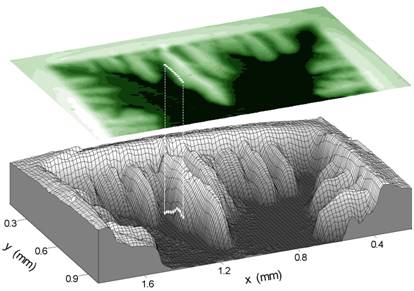Superconductivity
 |
by E. Altshuler
Superconductivity is a strange phenomenon, and also a scientific field plenty of contradictions. While the study of Superconductivity has produced several Nobel prizes since 1911, a number of fundamental questions remain unanswered. Moreover, being a phenomenon with a clear potential to produce technological revolutions both in high and low power electrical applications (specially after the discovery of "High Tc" materiales in the late 1980's), these applications have not crystallized yet in large scale. Scientists have always kept doing research in the field, against a background of widely-swinging financial support. Our group works (and have worked) in different aspects of Superconductivity, ranging from vortex avalanches to transport properties of polycrystals.

Avalanches in Superconductors
Avalanches come naturally to our mind when talking about mountains covered by snow. But they take place in incrediby distinct scenarios. One of them is the mixed state of Superconductors. When a big enough magnetic field is applied to a type II superconductor, tiny tornados of current called vortices penetrate the material, interacting repulsively amongst them, and attractively with the structural defects of the material. It can result in a discontinuos movement of the vortices that can eventually resemble the avalanches in a mountain or in a pile of sand as grains are slowly added from top (see my review on the subject here ). Using microHall probes and Magnetooptical images, we have investigated how far one can pull the analogy by studying the statistics of such avalanches. We have proved that the statistical distribution of avalanche sizes in superconducting Nb follows a power law whose slope is quite independent from the "magnetic landscape" where it takes place. To get our papers in the subject, click here.
Transport properties
I'd say that polycrystals and, specifically, ceramics, are regarded as the Cinderella of superconductors: they are too complicated to allow unveil their subtleties easily. But this turns to be attractive from the intellectual point of view (and, specially, when you don't have "nicer" samples at hand!). We have devoted several years in studying the high-temperature, low-field properties of polycrystalline High Temperature superconductors from all the highest Tc compounds: YBCO, BSCCO, TBCCO and HBCCO. We have concentrated in the hysteresis and relaxation of their transport properties, finding ways to measure intra-granular parameters indirectly through simple transport measuments. The main physical idea beyond these works is the fact that the grain magnetization due to intragranular superconducting currents affects the Josephson-like unions between the grains. Since transport properties are sensitive to the state of these unions, they can indirectly probe the intra-grain properties. Lately, we have been extending our results to BSCCO-Ag superconducting tapes --some of the best candidates for power transmission in a near future. In order to examine intra- and inter-grain properties, we have created a technique for laser cutting of the tapes, which has proved to be quite useful. To get our papers in the subject, click here .

Hot spots
What happens if, due to an inhomogenity, a section of a current-carrying superconducting stripe suddenly warms up?. Does the resulting "hot-spot" maintains its shape in time, or it "spreads", invading the rest of the stripe?. These questions can be extremely relevant to applications. We are currently studying them both theoretically, and by means of thermal imaging of YBCO stripes, in collaboration with the Physics Department, University of Oslo .

Josephson junctions vs. pendula
Lord Kelvin used to say that he only understood things when he had been able to construct in his mind a mechanical model of the phenomenon under consideration. We perfectly resonate with such idea. One of the teaching challenges we have enjoyed the most is to devise a system of coupled pendula to understand systems of superconducting Josephson junctions. Our pendula are simple, but you can tune mechanical parameters that represent excitation currents, gauge-invariant phase differences and the like, and compare the output with its analogue in real junctions. You can read an opinion of this work by the president of the AAPT here.
| "Henri Poincare" Complex
System Group- Contact us |